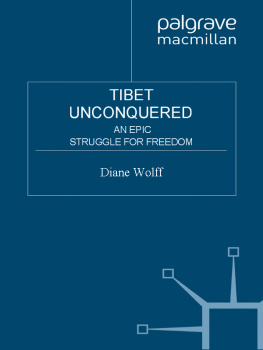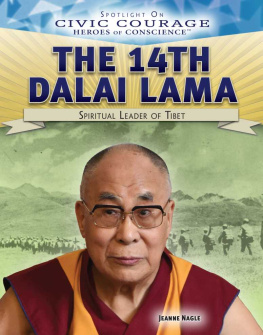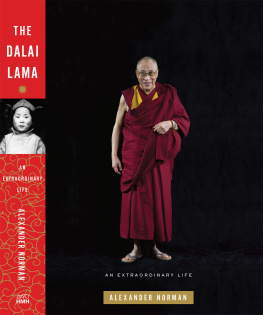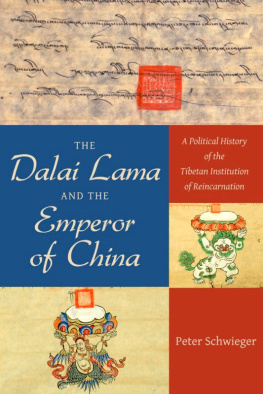TIBET UNCONQUERED
TIBET UNCONQUERED
AN EPIC STRUGGLE FOR FREEDOM

DIANE WOLFF
FOREWORD BY
ROBERT THURMAN


TIBET UNCONQUERED
Copyright Diane Wolff, 2010.
All rights reserved.
First published in 2010 by
PALGRAVE MACMILLAN
in the United Statesa division of St. Martins Press LLC,
175 Fifth Avenue, New York, NY 10010.
Where this book is distributed in the UK, Europe and the rest of the world, this is by Palgrave Macmillan, a division of Macmillan Publishers Limited, registered in England, company number 785998, of Houndmills, Basingstoke, Hampshire RG21 6XS.
Palgrave Macmillan is the global academic imprint of the above companies and has companies and representatives throughout the world.
Palgrave and Macmillan are registered trademarks in the United States, the United Kingdom, Europe and other countries.
ISBN: 9780230622739
Library of Congress Cataloging-in-Publication Data
Wolff, Diane.
Tibet unconquered : an epic struggle for freedom/by Diane Wolff; foreword by Robert A.F. Thurman.
p. cm.
Includes bibliographical references and index.
ISBN 9780230622739 (hbk.)
1. ChinaRelationsChinaTibet. 2. Tibet (China)RelationsChina. 3. Tibet (China)History. 4. Tibet (China)Politics and government. 5. ChinaPolitics and government. 6. ImperialismHistory.
I. Title.
DS740.5.T5W65 2010
951.505dc22 2010013066
A catalogue record of the book is available from the British Library.
Design by Newgen Imaging Systems (P) Ltd., Chennai, India.
First edition: September 2010
10 9 8 7 6 5 4 3 2 1
Printed in the United States of America.
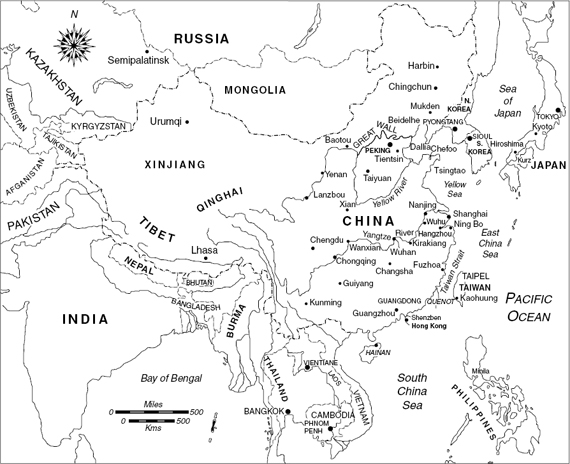
China and Its Neighbors
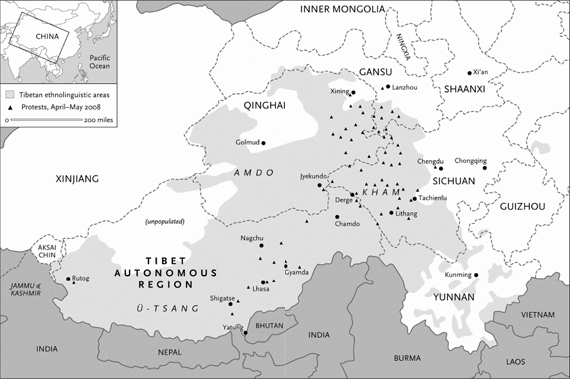
Ethnic Tibetan Areas of China
FOREWORD
I am pleased and honored to introduce Diane Wolffs brilliant work, as she gallops us across an 800-year swathe of history of China and Tibet. She carries us along in a knowledgeable and inspirational charge to share her vision of a win-win future awaiting the governments and peoples of the two nations, a solution for the current struggle between them based on the realities of history and the exigencies of the present. We begin by riding with Chinggis Khan across the steppes in his early period of the unification of the Mongolian nations, his conquest of north China, and his pragmatic engagement with Yeh-lu Chu-tsai in creating the loose reins pattern of workable empire. We end in a plausible future where the present Peoples Republic of Chinas government has discovered the ethical superiority and practical workability of a modern network version of the historical pattern of China-based empires of loose-reins management of the border states under its protection (rather than the unethical, increasingly impractical, realistically obsolete twentieth-century attempt by would-be superpower nation states to incorporate and assimilate neighboring nations).
After an exhilarating ride through history, when she comes down to the present, she makes many interesting points in her road map for a solution to Chinas Tibetan problem. She explains clearly how the thinking of the current Chinese leadership is still influenced by the Leninist approach to the ethnic question, and she strongly points out how the twentieth century proved that ethnicity is a more enduring human characteristic than class. Hard-line assimilation of ethnic groups has not worked anywhere on the planet and will not work in Tibet. Stubborn clinging in the twenty-first century of global media transparency to the effort of replicating the United States nineteenth-century genocidal policy regarding the Native American peoples (which still has not succeeded and remains one of the United States greatest sources of shame and denial to this day) is particularly self-defeating.
Wolffs urging that economic development alone will not satisfy either Chinas own people or her ethnic minority nationalities without political reform and empowerment through replacing centralized command control with the modern network model of classical Chinese loose-reins control is realistic. Her ensuing vision, inspired by the suggestion of South Koreas political theorist Dr. Han, of using a truly autonomous, regionally empowered, satellite Tibet to create a mountain coastal region of interaction with the South Asian Association for Regional Cooperation (SAARC) is brilliant. China would be offering a true portal of economic interaction with the seven nations of SAARC which would create a natural prosperity in the region, and save China the continuing embarrassment of an oppressed and restive Tibetan people and the huge waste of the subsidies required in the futile effort to turn Tibet into a hermetically sealed-off colony of China, filled with altitude-challenged Han colonists suffering in the rarified air.
Wolff cogently argues that, left to their own devices with relaxed supervision, protection, and support from the Chinese federal center, the Tibetans themselves would restore their threatened environment that should nurture the headwaters of Chinas and all of Asias major river systems, would re-create their inspiring, peaceful, and radiant Buddhist culture and educational systems, and would make Tibet a prosperous zone of sustainable economic development based on ecological, spiritual, and health tourism, while restoring Tibets traditional role as a hub of trade in the Himalayan region. The mineral and resource exploitation that the PLA businesses are concerned about could still continue, though a modern green environmental policy monitored by Tibetan agencies would involve some additional investment to avoid pollution and damage to the ecosystem. This extra cost would be more than compensated for by the greater ease of partnerships with global mining concerns who would no longer be constrained by the ethical and public relations problems of working in an oppressive human rights atmosphere. Her main point is that Chinas Tibet, thus released into a truly autonomous, regionally empowered satellite status, would be transformed from being an embarrassment for China into being a jewel in her crown, a regional leader of its neighboring Himalayan states and an efficient portal for Chinas trans-Himalayan trade with India and other SAARC members.
Wolff intriguingly perceives what few other observers have, that Tibetans, despite their Buddhistically restrained, basically nonviolent approach to resistance, have long been engaged in a unique kind of insurgency. Thus, the rule that the United States and others have been too slow to discover in Vietnam, Iraq, and Afghanistan, also applies to Tibet, that You cannot kill your way out of an insurgency. You have to make friends. You have to develop economically and politically! She is also well attuned to the extreme importance of the Tibetan plateau to the environmental health of China herself and the whole of Southeast and Southern Asia, since the headwaters of the Yellow, Yang-tze, Mekong, Salween, Iriwaddy, Brahmaputra, Ganges, Sutlej, and Indus River systems lie in Tibet. The frenzied pace of Chinas capitalist development and her intense hunger for basic resources of timber, meat, leather, and minerals has caused Chinese extractive industries to operate with no concern for the environment or sustainability. Fifty years of such policies have wreaked untold harm on the sensitive high-altitude ecosystems. Reform in these policies and systematic investment in repairing the damage would do wonders for Chinas own water crises, both floods and extreme shortages, and those of her southern neighbors and vastly improve Chinas international image.
Next page
